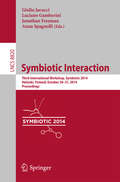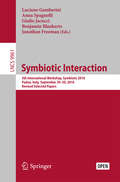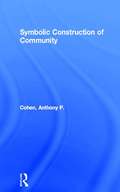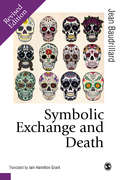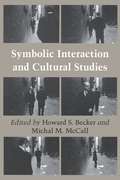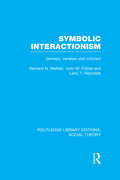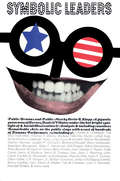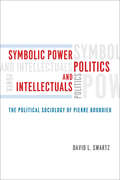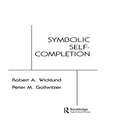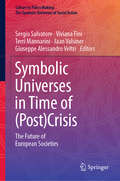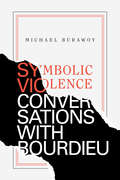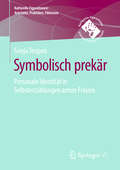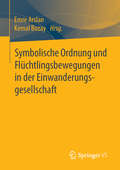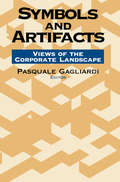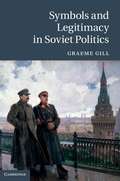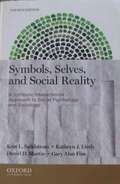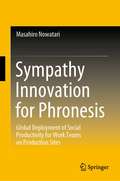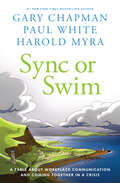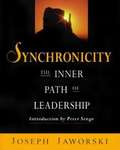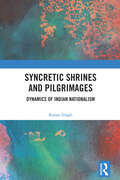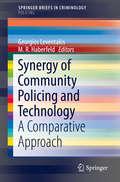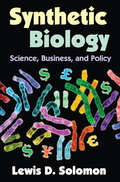- Table View
- List View
Symbiotic Interaction
by Giulio Jacucci Luciano Gamberini Jonathan Freeman Anna SpagnolliThis book constitutes the proceedings of the third International Workshop on Symbiotic Interaction, Symbiotic 2014, held in Helsinki, Finland, in October 2014. The 8 full papers and 5 short papers presented in this volume were carefully reviewed and selected from 16 submissions. They are organized in topical sections named: definitions of symbiotic interaction; reviews of implicit interaction; example applications; experimenting with users; and demos and posters.
Symbiotic Interaction
by Giulio Jacucci Luciano Gamberini Jonathan Freeman Anna Spagnolli Benjamin BlankertzThis book constitutes the proceedings of the 4th International Workshop on Symbiotic Interaction, Symbiotic 2015, held in Berlin, Germany, in October 2015. The 11 full papers and 8 short papers presented in this volume were carefully reviewed and selected from 23 submissions. The papers present an overview of the symbiotic relationships between humans and computers as well as novel advancements. The idea of symbiotic systems put forward in this workshop capitalises on the computers' ability to implicitly detect the users goals and psycho-physiological states and thereby enhancing human-computer interaction (HCI). A special focus of this year's Symbiotic Workshop will be on physiological computing approaches, e. g. using brain-computer interface (BCI) technology.
Symbolic Construction of Community (Key Ideas)
by Anthony P. CohenAnthony Cohen makes a distinct break with earlier approaches to the study of community, which treated the subject in largely structural terms. His view is interpretive and experiential, seeing the community as a cultural field with a complex of symbols whose meanings vary among its members. He delineates a concept applicable to local and ethnic communities through which people see themselves as belonging to society. The emphasis on boundary is sensitive to the circumstances in which people become aware of the implications of belonging to a community, and describes how they symbolise and utilise these boundaries to give substance to their values and identities.
Symbolic Exchange and Death (Published in association with Theory, Culture & Society #Vol. 25)
by Jean BaudrillardJean Baudrillard is one of the most celebrated and most controversial of contemporary social theorists. This major work occupies a central place in the rethinking of the humanities and social sciences around the idea of postmodernism. It leads the reader on an exhilarating tour encompassing the end of Marxism, the enchantment of fashion, symbolism about sex and the body, and the relations between economic exchange and death. Most significantly, the book represents Baudrillard′s fullest elaboration of the concept of the three orders of the simulacra, defining the historical passage from production to reproduction to simulation. A classic in its field, Symbolic Exchange and Death is a key source for the redefinition of contemporary social thought. Baudrillard′s critical gaze appraises social theories as diverse as cybernetics, ethnography, psychoanalysis, feminism, Marxism, communications theory and semiotics. This English translation begins with a new introductory essay.
Symbolic Exchange and Death (Published in association with Theory, Culture & Society #Vol. 25)
by Professor Jean BaudrillardJean Baudrillard is one of the most celebrated and most controversial of contemporary social theorists. This major work occupies a central place in the rethinking of the humanities and social sciences around the idea of postmodernism. It leads the reader on an exhilarating tour encompassing the end of Marxism, the enchantment of fashion, symbolism about sex and the body, and the relations between economic exchange and death. Most significantly, the book represents Baudrillard's fullest elaboration of the concept of the three orders of the simulacra, defining the historical passage from production to reproduction to simulation. A classic in its field, Symbolic Exchange and Death is a key source for the redefinition of contemporary social thought. Baudrillard's critical gaze appraises social theories as diverse as cybernetics, ethnography, psychoanalysis, feminism, Marxism, communications theory and semiotics. This English translation begins with a new introductory essay.
Symbolic Interaction and Cultural Studies
by Becker, Howard S. and McCall, Michal M.Symbolic interactionism, resolutely empirical in practice, shares theoretical concerns with cultural studies and humanistic discourse. Recognizing that the humanities have engaged many of the important intellectual currents of the last twenty-five years in ways that sociology has not, the contributors to this volume fully acknowledge that the boundary between the social sciences and the humanities has begun to dissolve. This challenging volume explores that border area.
Symbolic Interaction and Cultural Studies
by Becker, Howard S. and McCall, Michal M.Symbolic interactionism, resolutely empirical in practice, shares theoretical concerns with cultural studies and humanistic discourse. Recognizing that the humanities have engaged many of the important intellectual currents of the last twenty-five years in ways that sociology has not, the contributors to this volume fully acknowledge that the boundary between the social sciences and the humanities has begun to dissolve. This challenging volume explores that border area.
Symbolic Interactionism: Genesis, Varieties and Criticism (Routledge Library Editions: Social Theory Ser.)
by Larry Reynolds Bernard Meltzer John PetrasSymbolic interactionsim is of major importance in contemporary sociology. In this study, three authorities in the field collaborate to define symbolic interactionism and to describe, and present criticism of, the interactionist perspective. The contributions of G.H. Mead, J. Dewey, C.H. Cooley, W.I. Thomas and other theorists to the interactionist viewpoint on human behaviour and social life are examined. There is a systematic discussion of the diverse schools of thought within the field, including H.G. Blumer’s Chicago School, M.H. Kuhn’s Iowa School, E. Goffman’s dramaturgical approach and H. Garfinkel’s ethnomethodology. Criticisms of symbolic interactionism by both adherents and opponents to the perspective are selected and assessed. Throughout the book, the authors survey the social and intellectual sources of significant ideas, thereby incorporating a reflexive, sociology-of-sociology orientation.
Symbolic Leaders: Public Dramas and Public Men
by Orrin E. KlappRadio, television and the press form the vast stage on which the public dramas of our time are played to a responsive audience of millions- the peoples of our nation and of the world. Almost anyone can steal the scene and become a public hero, a favorite villain or a lamented victim. How do these persons-the symbolic leaders-emerge? Who are they? How does the climate of public opinion affect the would-be leader? How does the public use its leaders?This book discusses how symbolic leaders emerge, how unknown people become symbolic and it analyzes the kinds of encounters that are likely to make individuals either ""heroes,"" ""villains,"" or ""fools."" The book portrays the ups-and-downs of public images, as well as crises and role reversals, in which parties may swap roles without meaning to. The book concludes with a final chapter, which deals with the concept of public drama and its implications for change as well as its instability in modern society.Symbolic Leaders is a probing and provocative analysis of the process of public drama and of the actors, who play the leading roles, discussed in terms of their significance for the structures of our rapidly changing society and illustrated by vivid case histories. Professor Klapp's lively style makes this work an eminently readable sociological study. The social scientist will find in it a challenging and original theory of social organization, which suggests strategic areas for further research. Public relations personnel will find it an invaluable practical handbook of clues for creating a public image. And the general reader will find Symbolic Leaders a fascinating and thought-provoking commentary on public life in our society.
Symbolic Power, Politics, and Intellectuals: The Political Sociology of Pierre Bourdieu
by David SwartzPower is the central organizing principle of all social life, from culture and education to stratification and taste. And there is no more prominent name in the analysis of power than that of noted sociologist Pierre Bourdieu. Throughout his career, Bourdieu challenged the commonly held view that symbolic power--the power to dominate--is solely symbolic. He emphasized that symbolic power helps create and maintain social hierarchies, which form the very bedrock of political life. By the time of his death in 2002, Bourdieu had become a leading public intellectual, and his argument about the more subtle and influential ways that cultural resources and symbolic categories prevail in power arrangements and practices had gained broad recognition. In Symbolic Power, Politics, and Intellectuals, David L. Swartz delves deeply into Bourdieu's work to show how central--but often overlooked--power and politics are to an understanding of sociology. Arguing that power and politics stand at the core of Bourdieu's sociology, Swartz illuminates Bourdieu's political project for the social sciences, as well as Bourdieu's own political activism, explaining how sociology is not just science but also a crucial form of political engagement.
Symbolic Self Completion
by R. A. Wicklund P. M. GollwitzerFirst published in 1982. Routledge is an imprint of Taylor & Francis, an informa company.
Symbolic Universes in Time of: The Future of European Societies (Culture in Policy Making: The Symbolic Universes of Social Action)
by Jaan Valsiner Sergio Salvatore Viviana Fini Terri Mannarini Giuseppe Alessandro VeltriThis book investigates whether, how and where the cultural milieu of European societies has changed as a result of the socio-economics crisis. To do so, it adopts a psycho-cultural approach, which views the cultural milieu as a set of meanings, placing the generalized image social actors have of themselves, the world, events and their relationships in the context of the socio-political and institutional environment, including policies. By analyzing the changes in cultural milieu and social identity, the book develops strategic and methodological guidelines for the design of post-crisis policies, providing a concept of how the cultural dynamics are associated with certain individual characteristics and specific socio-economic phenomena.
Symbolic Violence: Conversations with Bourdieu
by Michael BurawoyIn Symbolic Violence Michael Burawoy brings Pierre Bourdieu into an extended debate with Marxism—a tradition Bourdieu ostensibly avoided. While Bourdieu's expansive body of work stands as a critique of Marx's inadequate account of cultural domination, Burawoy shows how Bourdieu's eschewal and rejection of Marxism led him to miss out on a number of productive theoretical engagements. In eleven &“conversations,&” Burawoy outlines the intellectual and biographical parallels and divergences between Bourdieu and the work of preeminent Marxist thinkers. Among many topics, Burawoy examines Bourdieu's appropriation and silencing of Beauvoir and her theory of masculine domination; the commonalities as well as differences in Bourdieu's and Fanon's thought on colonialism and revolution; the extent to which Gramsci's theory of hegemony aligns with Bourdieu's notion of symbolic violence; and both how Freire and Bourdieu understood education as the site of oppression. In showing how Bourdieu has more in common with these thinkers than Bourdieu himself cared to admit, Burawoy offers a critical assessment of Bourdieu's work that illuminates its paradoxes and reaffirms its significance for the twenty-first century.
Symbolisch prekär: Personale Identität in Selbsterzählungen armer Frauen (Kulturelle Figurationen: Artefakte, Praktiken, Fiktionen)
by Sonja TeupenIm Zentrum der mikrosoziologisch und kulturpsychologisch informierten Studie steht die Subjektposition der armen Frau. Im Unterschied zu anderen Subjektpositionen geht diese nicht mit einem Versprechen sozialer Anerkennung einher, sondern erfolgt vorrangig unter Bedingungen symbolischer Prekarität. Anhand von Selbsterzählungen von Frauen in Armutslagen in Deutschland und den USA wird untersucht, wie die Erzählerinnen ihr Subjektsein narrativ verhandeln und damit personale Identität konstituieren. Die Analyse im methodologischen Rahmen der relationalen Hermeneutik rekonstruiert zwei Ebenen des Gegenstandes: Thematisch plausibilisieren die Erzählerinnen ihr Armsein entlang der Topoi Krankheit, Trennung, Kindheit und Schicksal. Strukturell sind ihre Erzählungen aufgespannt zwischen den Punkten Widerfahrnis und Handlung, Identifikation und Differenz, Zurechnung und Autonomie.Der InhaltEinführungSozial- und kulturwissenschaftliche Identitätsforschung im interpretativen ParadigmaPersonale IdentitätMethodik der Analyse personaler IdentitätFallvergleich und Typisierung: AnalyseTopik und Typologie: DiskussionSchlussDie AutorinDr. Sonja Teupen ist Wissenschaftliche Mitarbeiterin für Qualitative Methoden am Deutschen Zentrum für Neurodegenerative Erkrankungen (DZNE), Standort Witten. Im Kontext der Demenz-Versorgungsforschung arbeitet sie unter anderem zum Thema Selbst und Personsein in sozialen Beziehungen. Daneben ist sie Lehrbeauftragte des Instituts für Soziologie an der FernUniversität in Hagen.
Symbolische Ordnung und Flüchtlingsbewegungen in der Einwanderungsgesellschaft
by Kemal Bozay Emre ArslanDas Thema der Flüchtlingsbewegungen ist in den letzten Jahren vielfach in den Fokus politischer, medialer und wissenschaftlicher Diskurse gerückt. Dabei geht es sowohl um eine globale Diskussion über die Fluchtthematik als solches als auch um die Lebensbedingungen von geflüchteten Menschen in der Aufnahmegesellschaft. Gegenwärtig kann beobachtet werden, dass die Willkommensstimmung gegenüber Geflüchteten größtenteils gekippt ist, und in der politischen, institutionellen und medialen Debatte über Geflüchtete eine Tendenz zur Kriminalisierung und Skandalisierung vorherrscht. Vielfältige aktuelle Forschungen haben sich interdisziplinär mit den unterschiedlichen Aspekten der Flüchtlingsbewegungen beschäftigt. Dieser Sammelband hat sich zum Ziel gesetzt, den Bourdieuschen Diskurs zur „Symbolischen Ordnung“ auf das Themenfeld „Flüchtlingsbewegungen“ zu übertragen und zu diskutieren.
Symbols and Artifacts: Views of the Corporate Landscape
by Pasquale GagliardiA selection of 18 papers from an international conference in Milan, June 1987, organized by the Standing Conference on Organizational Symbolism. Details how corporate artifacts are invested with meaning, are related to control, and can be used as cultural indicators in research. Among the topics are office design, housing modifications, computer systems, and the space shuttle. Fairly devoid of specialist jargon.
Symbols and Legitimacy in Soviet Politics
by Graeme GillSymbols and Legitimacy in Soviet Politics analyses the way in which Soviet symbolism and ritual changed from the regime's birth in 1917 to its fall in 1991. Graeme Gill focuses on the symbolism in party policy and leaders' speeches, artwork and political posters, and urban redevelopment, and on ritual in the political system. He shows how this symbolism and ritual were worked into a dominant metanarrative which underpinned Soviet political development. Gill also shows how, in each of these spheres, the images changed both over the life of the regime and during particular stages: the Leninist era metanarrative differed from that of the Stalin period, which differed from that of the Khrushchev and Brezhnev periods, which was, in turn, changed significantly under Gorbachev. In charting this development, the book lays bare the dynamics of the Soviet regime and a major reason for its fall.
Symbols, Selves, and Social Reality: A Symbolic Interactionist Approach to Social Psychology and Sociology
by Gary Alan Fine Kent L. Sandstrom Daniel D. Martin Kathryn J. LivelyThe fourth edition of Symbols, Selves, and Social Reality provides students with a succinct, engaging, and affordable introduction to symbolic interactionism--the perspective that social reality is created, negotiated, and changed through the process of social interaction. Focusing on how elements of race and gender affect identity, the authors use real-world examples to discuss the personal significance of symbolic interactionism, its expanding theoretical scope, and its relationship to other prominent perspectives in sociology and social psychology. They skillfully cover empirical research topics that are inherently interesting to students, such as the dynamics of self-development, impression management, identity transformation, gender play, rumor transmission, and collective action.
Sympathy Innovation for Phronesis: Global Deployment of Social Productivity for Work Teams on Production Sites
by Masahiro NowatariThis book explores social productivity in work teams on production sites, with an eye toward human welfare. It focuses especially on "sympathy management" by the use of multivariate analysis in a worldwide social survey. Manufacturing production sites have many work teams, and their activities support productivity. Productivity, however, is evaluated only by the production system. Therefore, the social system's sympathy evaluation as teamwork in the work team is completely disregarded by management activity. Management recognizes this social system and must upgrade teamwork as a social system from tacit to explicit knowledge as an appraisal system. Thus, this new paradigm significantly contributes to industrial society beyond conventional management. The work team's social system functions in a production system and affects team productivity. Therefore, it must take a bird's-eye view of social productivity as an overall strategy. Social productivity has two appraisal criteria, the social system's sympathy and the production system's productivity. Increasing explicit knowledge of sympathy as teamwork requires the perspective of human-social science. Social productivity has been verified through global deployment by social research and case studies and contributes to humankind's welfare on sustainable development goals and ISO56000, an innovation management system. Social productivity can also decrease opportunity loss based on ignoring the social system of the work team.
Sync or Swim: A Fable About Workplace Communication and Coming Together in a Crisis
by Gary Chapman Paul White Harold MyraWorking with a discouraged, disorganized, cynical team? Learn how to turn it around.Sync or Swim is a small tale with enormous insight on ways you can empower, engage, and energize employees or volunteers facing discouragement or cynicism. Sam, the new CEO, was ready to hit the ground running. But his team members—and Mother Nature—had other plans.An ambitious yet naïve sheepdog is called upon to lead Monarch Enterprises, a troubled organization on a beautiful isle. Confronted with broken systems and challenging personality types, Sam must learn how to marshal his team before the imminent storm washes everything away. Along the way, he gleans valuable lessons from an unlikely mentor: a wise, old puffin. This delightful, quick read will: Teach you communication techniques that enhance teamwork and productivityBring to life the principles used by hundreds of successful organizationsProvide relevant, practical insights based on real-world experiencesStimulate lively and positive interaction (discussion guide included)Based on the principles successfully used by major corporations, health organizations, over 250 colleges and universities, government agencies, churches, and non-profits
Sync or Swim: A Fable About Workplace Communication and Coming Together in a Crisis
by Gary Chapman Paul White Harold MyraWorking with a discouraged, disorganized, cynical team? Learn how to turn it around.Sync or Swim is a small tale with enormous insight on ways you can empower, engage, and energize employees or volunteers facing discouragement or cynicism. Sam, the new CEO, was ready to hit the ground running. But his team members—and Mother Nature—had other plans.An ambitious yet naïve sheepdog is called upon to lead Monarch Enterprises, a troubled organization on a beautiful isle. Confronted with broken systems and challenging personality types, Sam must learn how to marshal his team before the imminent storm washes everything away. Along the way, he gleans valuable lessons from an unlikely mentor: a wise, old puffin. This delightful, quick read will: Teach you communication techniques that enhance teamwork and productivityBring to life the principles used by hundreds of successful organizationsProvide relevant, practical insights based on real-world experiencesStimulate lively and positive interaction (discussion guide included)Based on the principles successfully used by major corporations, health organizations, over 250 colleges and universities, government agencies, churches, and non-profits
Synchronicity: The Inner Path of Leadership
by Joseph JaworskiSynchronicity is an inspirational guide to developing the most essential leadership capacity for our time: how we can collectively shape our future.
Syncretic Shrines and Pilgrimages: Dynamics of Indian Nationalism
by Karan SinghThis book looks at various syncretic traditions in India, such as Bhakti, Nath Yogi, Sufi, Imam Shahi, Ismailis, Khojas and others, and presents an elaborate picture of a redefined cultural space through them. It also investigates different syncretisms - Hindu-Muslim, Hindu-Muslim-Christian and Aboriginal-Ethnic - to understand diverse aspects of hybridity within the Indian nation space. It discusses how Indian nationalism was composed of different opinions from its inception, reflecting its rich diversity and pluralistic traditions. The book traces the emergence of multiple contours of Indian nationalism through the historical trajectory of religious diversity, lingering effects of colonialism, and experimentation with secularism. This volume caters to scholars and students interested in cultural studies, religion studies, pilgrimage studies, history, social anthropology, historical sociology, historical geography, religion and art history. It will also be of interest to political theorists and general readers.
Synergy of Community Policing and Technology: A Comparative Approach (SpringerBriefs in Criminology)
by M. R. Haberfeld Georgios LeventakisThis brief examines the interaction and synergy between the philosophical concepts embedded in the ideas of Community Oriented Policing (C.O. P.) and urban security aided by technological innovations. While the philosophy of C.O.P. stresses the importance of collaboration between members of the public and its police forces technology that is becoming rapidly integrated in various police tactics creates new legal challenges and operational hurdles. This approach, coined as “Next Generation Community Policing”, is discussed through the chapters of the brief and illustrated with examples from a number of different countries and their approaches to this topic.
Synthetic Biology: Science, Business, and Policy
by Lewis D. SolomonFor nearly forty years, using recombinant DNA tools, researchers, and then businesses, have genetically engineered organisms by transferring naturally occurring genes from one organism into another. Doing so modifies the genetic code of living cells, imparting new traits and achieving desired results; this is done in the production of proteins, pharmaceuticals, and seeds. Synthetic biology, argues Solomon, could free scientists from the need to find natural genes to make such desired modifications. Synthetic biology permits more complex and sophisticated bioengineering than what can be achieved through previous genetic modification techniques. Drawing on non-biological scientific and engineering disciplines, including information technology and nanotechnology, synthetic biology strives to rearrange an organism's genes on a far wider scale by rewriting its genetic code, the chemical instructions need to design, assemble, and operate a species. By allowing the writing of artificial genetic codes, synthetic biology can transform existing industries and spawn new ones, creating new products as well as radically reshaping existing items. Arguing for self-regulation by the scientific and business communities, Lewis D. Solomon recommends a policy framework that would guard against governmental overregulation, which could create a barrier to innovation. Although synthetic biotechnology holds considerable social and economic potential, absent a nurturing regulatory climate, it may prove difficult to translate research discoveries into commercially viable applications.
